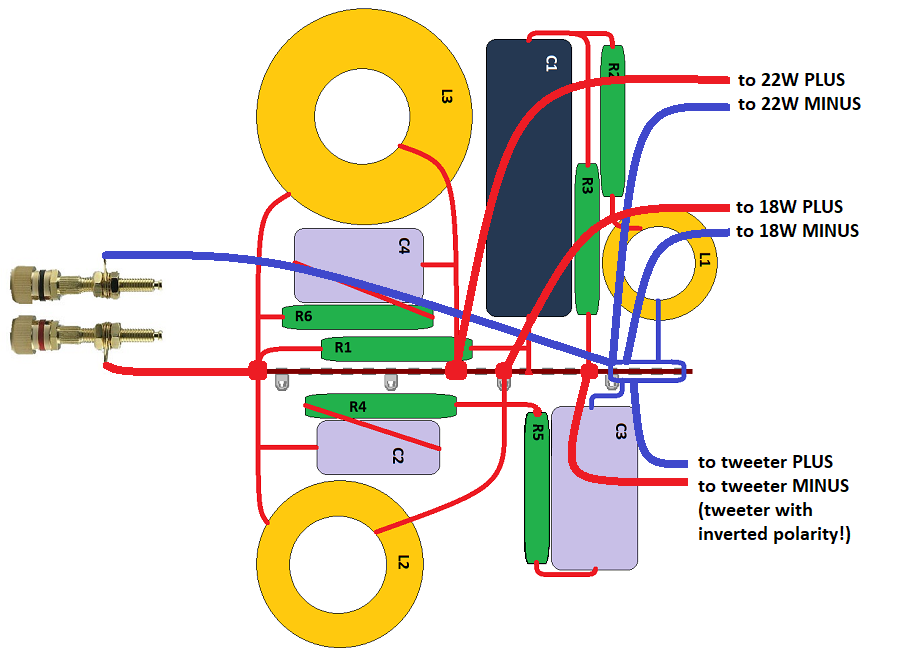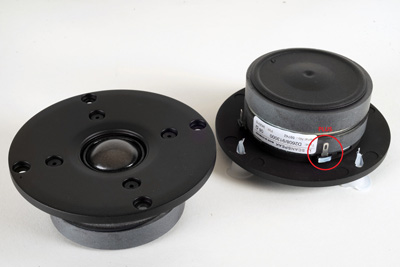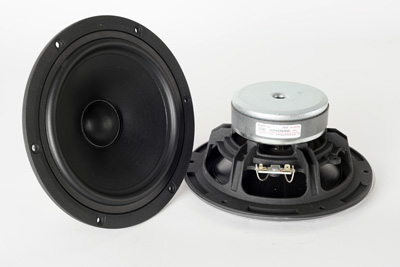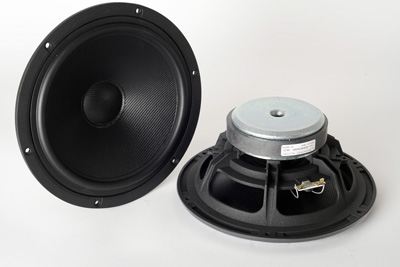ScanSpeak Discovery
861
Copyright 2022 © Troels Gravesen
Go to on this page:
DRIVERS
CROSSOVER
CABINET
MEASUREMENTS
SPEAKER-KIT
CROSSOVER LAYOUT
I previously made a
"761"
2½-way and it has been well received and the logical thing -
to me - is the creation of a bigger variant with an 8" bass driver to
further increase bass output. What was my primary objective was
simplicity of cabinet and crossover and to provide as much value as
possible for the investment.
I have used all the drivers here in other constructions and from
simulation it appeared an easy task to put together a bigger
speaker that might fulfill that ambition. Based on simulation we might
get a fairly efficient speaker and indeed some 91-92 dB/2.8V is achieved.
This speaker runs from modest amplifiers and even my 15 watt EAR-869
does very well given the speaker's benign impedance profile.
Obviously we need a larger cabinet to accommodate an 8" bass driver and
width is increased to 25 cm, depth to 30 cm and height is now 105 cm
without feet. Still, what I reckon a slim floor-stander.
The benefit of running an 8" and 6" in a 2½-way fashion is the increase
in membrane area to around 370 cm^2, more than most 10" bass drivers and
while the 8" bass driver from its vented cabinet delivers the low-end,
the 6" in its closed cabinet delivers the punch in upper bass as needed.
What I had not foreseen was the exceptional smooth response of the
18W/8434G00 on this particular baffle. From a designers perspective a
dream scenario. Smooth all the way to 7 kHz. See measurements
below. Equally well behaved are the 8" bass
driver and tweeter. Having almost ideal frequency response profiles also
provides an endless options for crossover design. Troublesome drivers
usually leaves you with fewer possibilities because there are
corrections and equalisation that just must be done. Here, it can go
forever with fine-tuning, raising or lowering the midrange half a
decibel or so - and how does it sound with solid state, tube amps, in
different rooms, etc. It can go on forever.
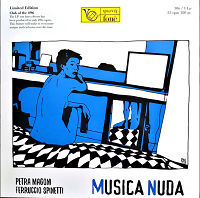
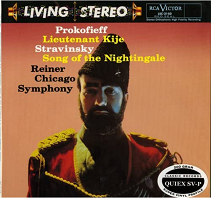
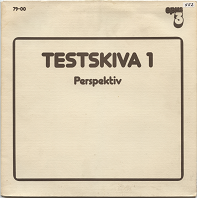

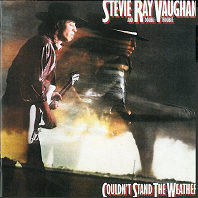
Musica Nuda was the first LP I put on the turntable after having
installed the speaker in our living room, and having just removed my
QUAD 2812 speakers I was expecting quite a change. It just didn't make
much of a change. The 18W midrange handling some 4½ octaves without a
glitz on frequency response displays a surprisingly transparent midrange
with no edginess whatsoever! Not even at significant levels.
The RCA Victor re-issue is a phenomenal recording and the 861 handles it
all with grace, delicacy, and ability to resolve even massed strings.
BTW: I used My Anna D cartridge on my Kuzma StabiR/4Point9 turntable and
also a Torlei
modified LINN Troika cartridge, lend to me by a friend. This Torlei guy
is a genius when it comes to re-tipping cartridges and this Troika comes
as close to an Anna D as I can imagine. It has the slight warmth of the
Anna D without sacrificing resolution and tracking ability, something
I've found it hard to find in other places.
A friend of mine gave me the old TESTSKIVA 1, and old test record from
OPUS3. Magnificent record with multiple examples of un-manipulated
acoustic music. On the 861 I enjoyed every single track.
I've shown the Yuko Mabuchi 45 rpm record before, but a good thing can't
be done too often. Take one single good 50'ies AKG stereo microphone and
a tape recorder - and you have credible presentation of a trio in a real
room. Let Bernie Grundman cut a 45 rpm vinyl. How hard can it be? The
861 detracts nothing from the authenticity of this venue.
Stevie Ray Vaughan, Tin Pan Alley, 45 rpm, the professional reviewers'
"let's get the hell out of this room" record. Nevertheless, a
magnificent recording. Now, the 861 does not have the bottom end weight
of my 18" BMS bass drivers - and they shouldn't. But still, a credible bass
line that goes deep and leaves no doubt what is going on. Remember your
room is half your system, so do experiments when setting up your
speakers.
I don't think I can make a stronger statement of what well engineered
drivers can do than the Discovery-861. Only thing may be that some
people think low-cost drivers just cannot be good - or simply doesn't
look as good as expensive drivers. Not much I can do about prejudice -
or the desire for luxury goods.
The 18+22W drivers deliver the weight in bass and lower midrange that
brings warmth to the sound, body to cellos, fullness to male vocals,
etc. The low order filters eliminates any hardness to wind
instruments or female vocals and makes a smooth presentation of cymbals.
I like it a lot.
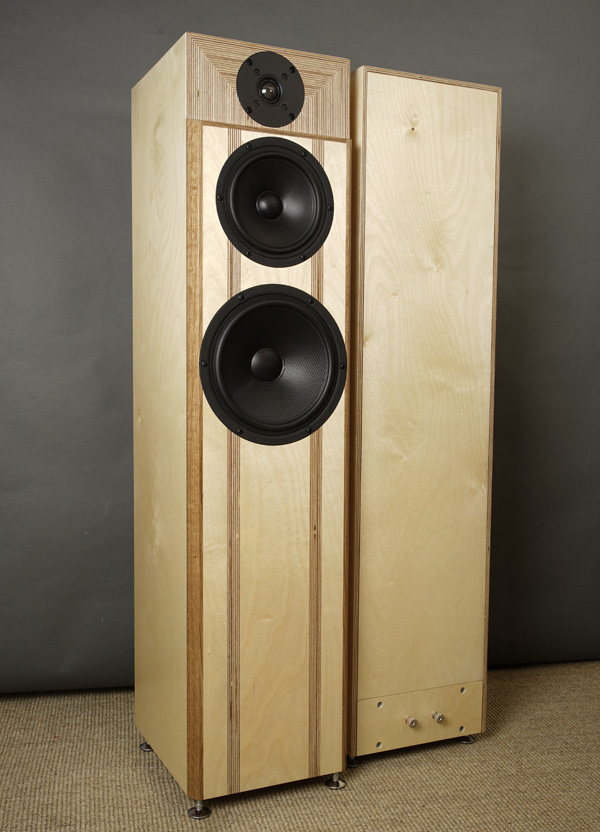
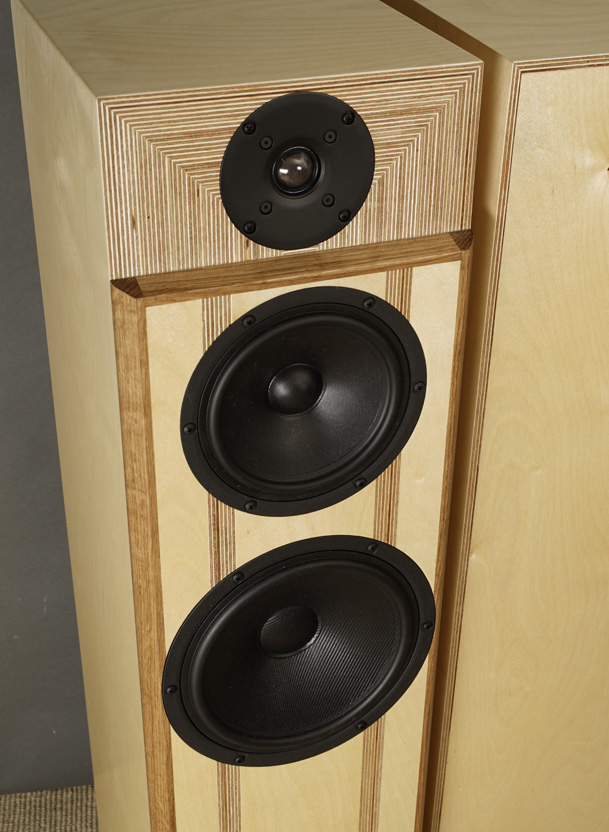
Basics:
3-driver speaker
Dimensions: 25 x 30 x 105 cm, WxDxH.
System sensitivity: 91-92 dB/2.8V/1 meter.
Impedance: 4-8 Ohms.
Point of crossover: 2800 Hz.
Power requirement: 15+ watts/channel. Obviously depends on room and how
loud you want to play.
Power handling: 100 watts. Please
also read:
http://www.troelsgravesen.dk/power-handling.htm,
and remember any burned driver is a misused driver.
Useful links (Please
follow all links before e-mailing!):
http://www.troelsgravesen.dk/tips.htm
http://www.troelsgravesen.dk/tips.htm#CONSTRUCTION_OF_CROSSOVERS
http://www.troelsgravesen.dk/crossovers.htm
http://www.troelsgravesen.dk/LCR-RC.htm
http://www.troelsgravesen.dk/Inverted-Polarity.htm
http://www.troelsgravesen.dk/choices.htm
http://www.troelsgravesen.dk/power-handling.htm
Download specs here: D2608/913000 18W/8434G00 22W/8534G00
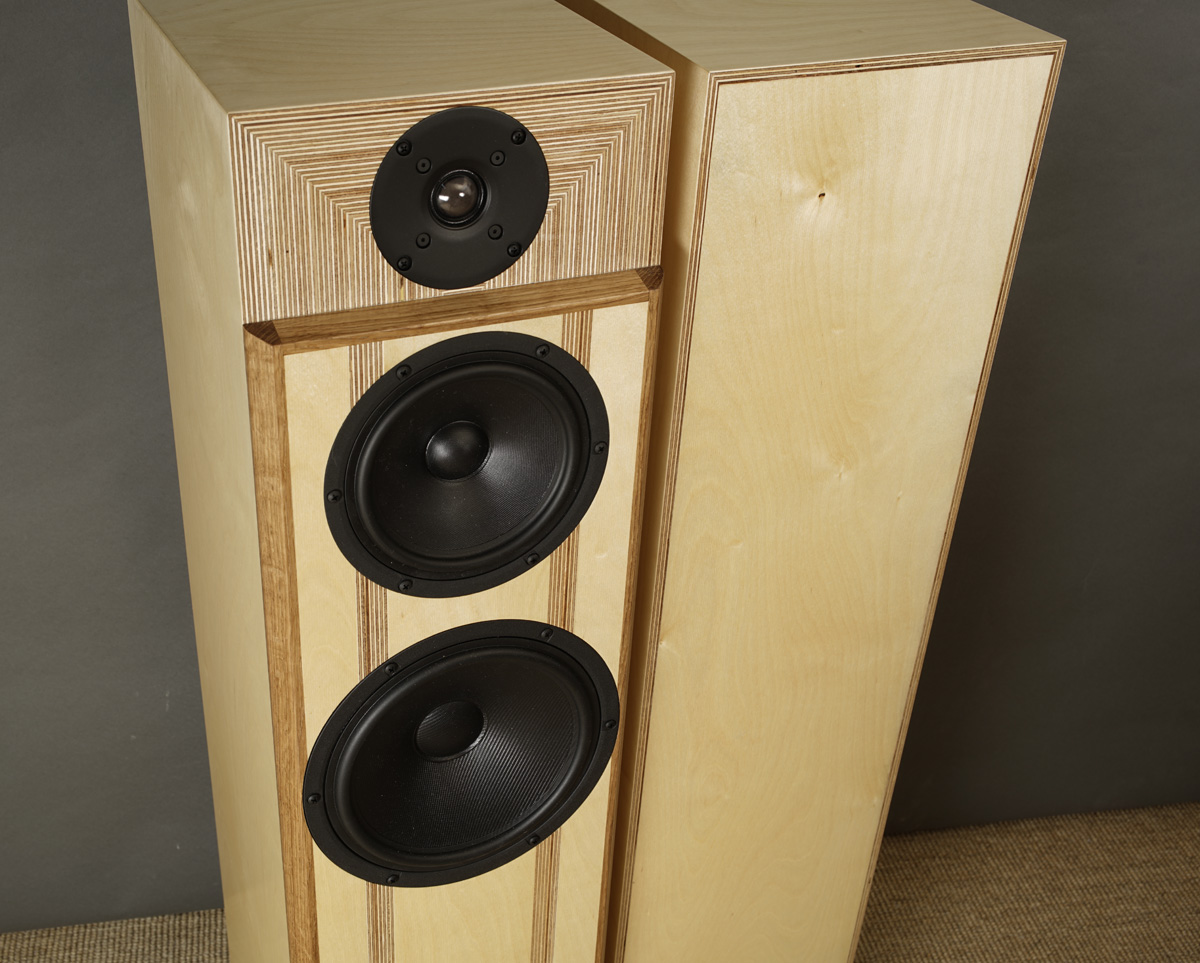
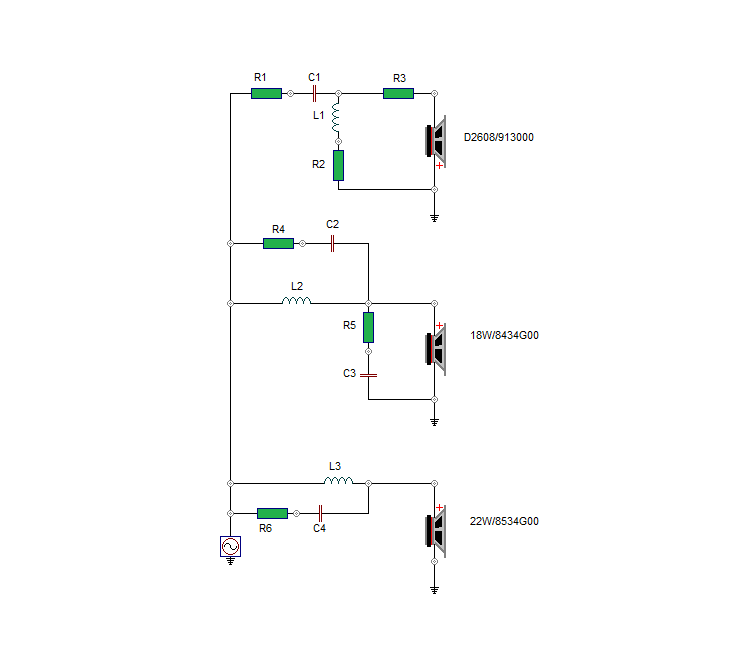
Both the 22W and 18W drivers feature 1st order roll-off profiles, where the tweeter has a standard LR2 filter. With inverted tweeter polarity this ensures proper summation from the stepped baffle alignment. Actually the 22W is smooth all the way to 9 kHz before giving up. Quite remarkable. The 18W can do the same, but for the sake of proper summation with the tweeter starts rolling off gradually 2nd to 4th order around 7 kHz.
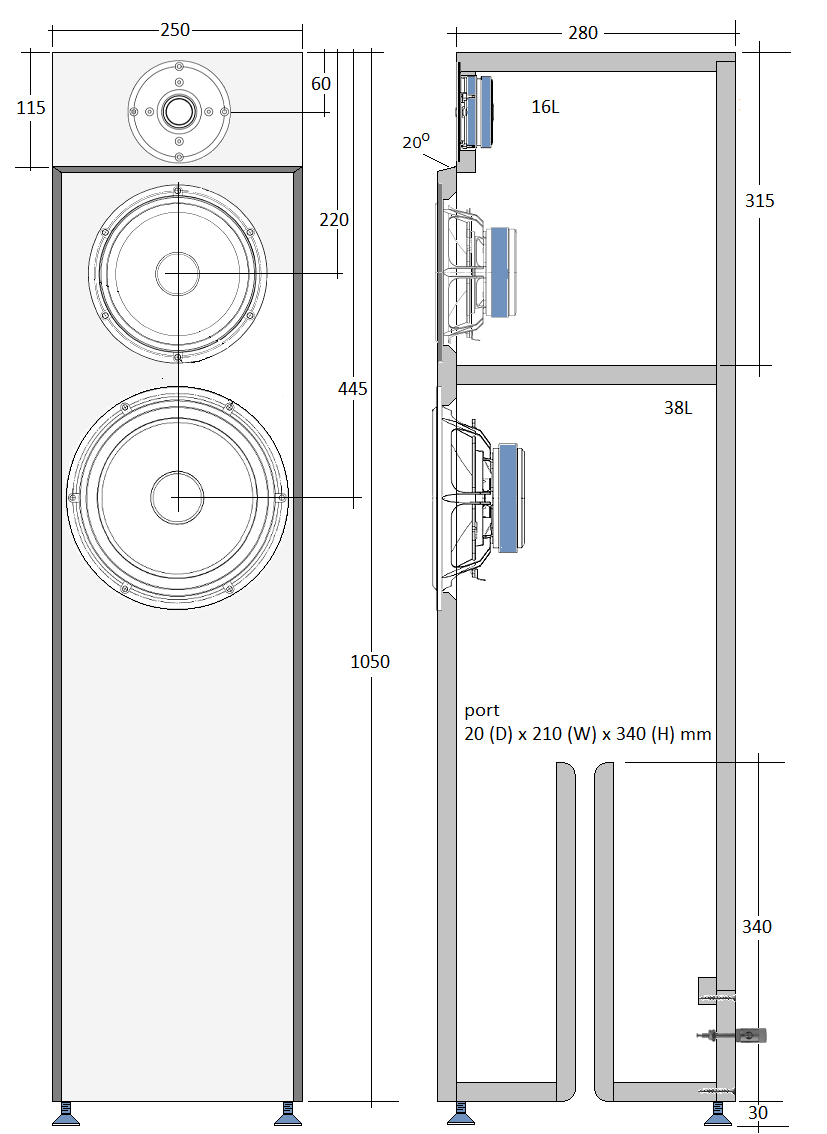
Cabinet is all simplicity and can be made from 19-22 mm panels without changing outer dimensions. I used 20 mm Baltic birch. Port is two pcs 21 x 34 cm panels placed in center of the cabinet. I suggest a small detachable rear panel for the binding posts as applying wires can be troublesome from a fixed rear panel. See drawing and photos.
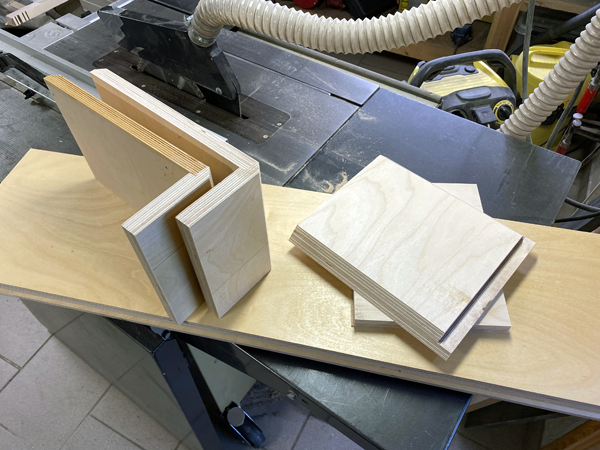
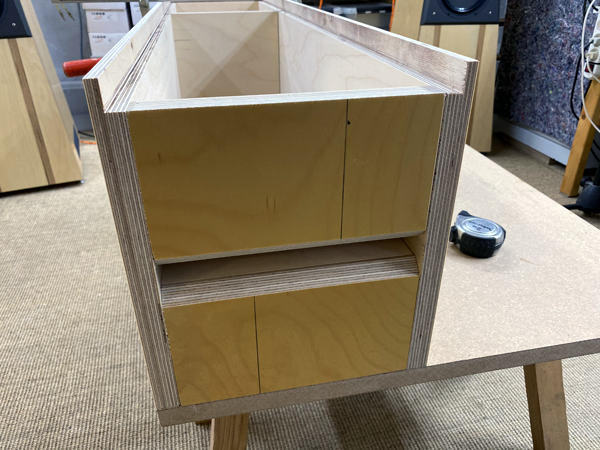
The port ends were chamfered 45 deg. to half depth of panel thickness.
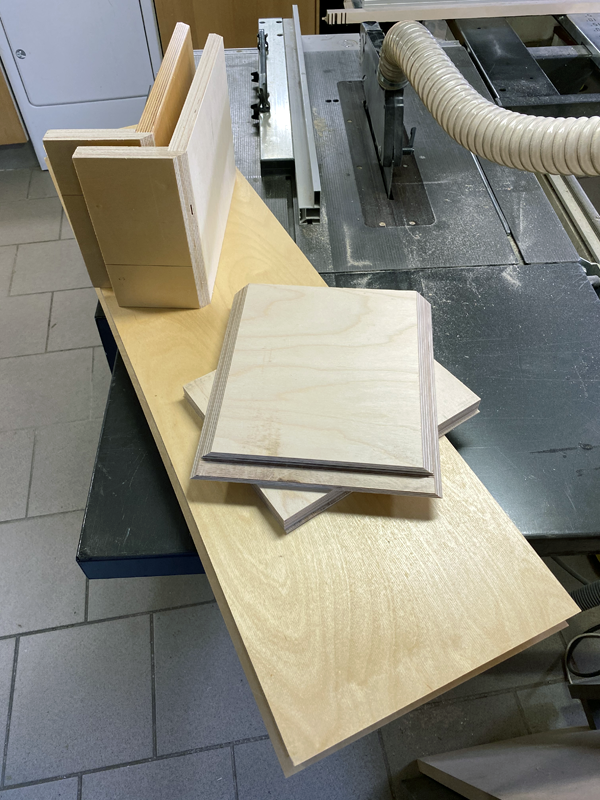
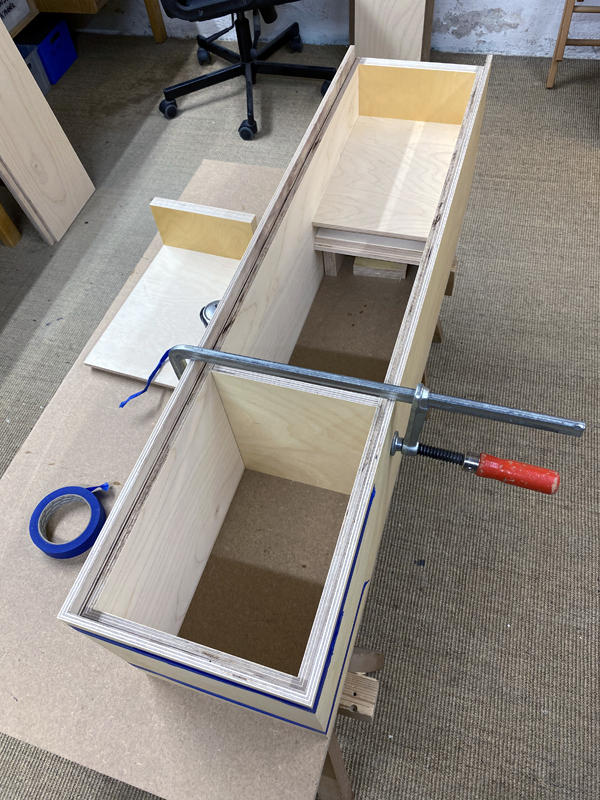
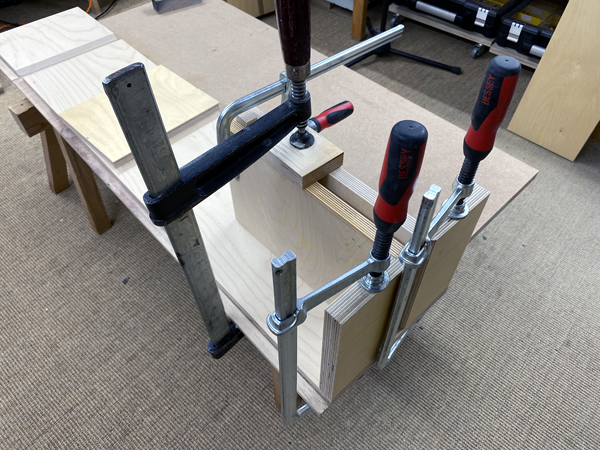
Start gluing the port panels and then glue them to one side panel. This makes final assembly much easier.
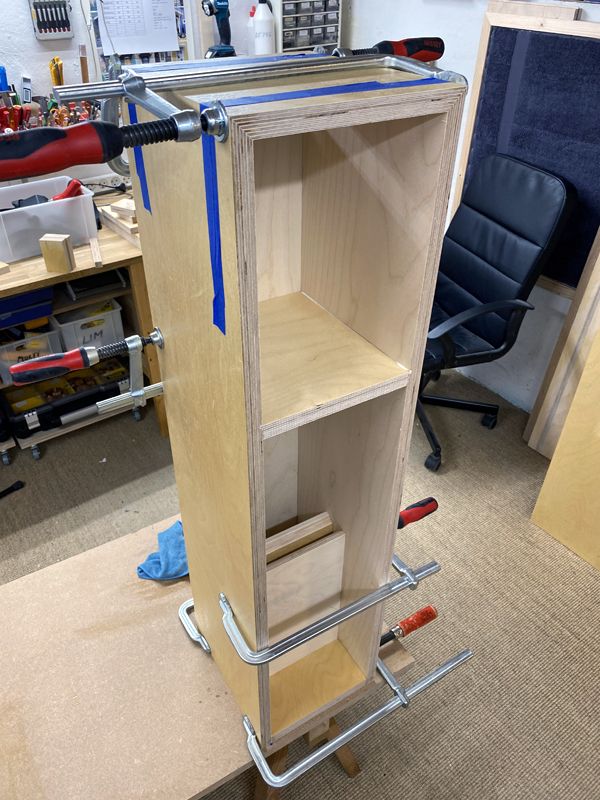
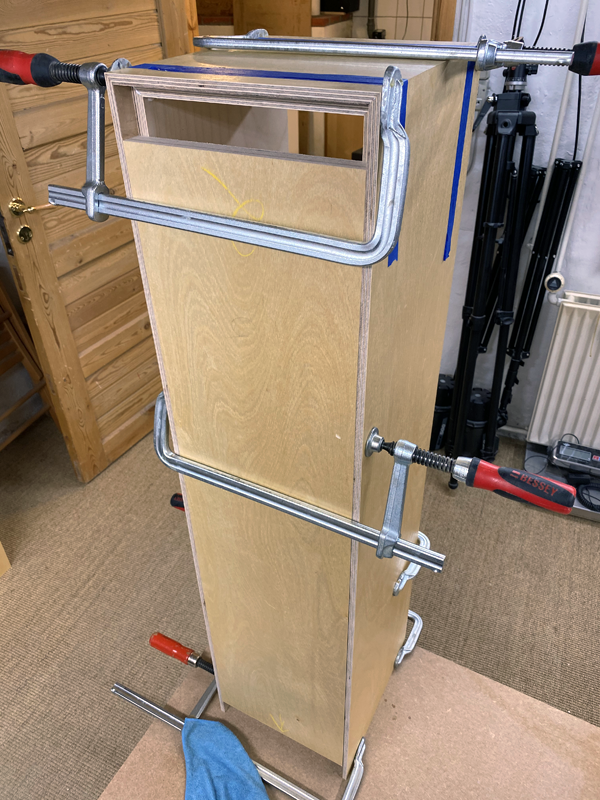
Glue top, side panels and bracing. Rear panel used here just for aligning the side panels.
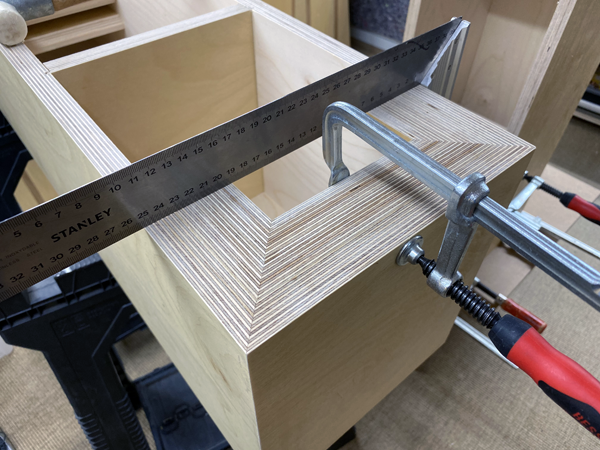
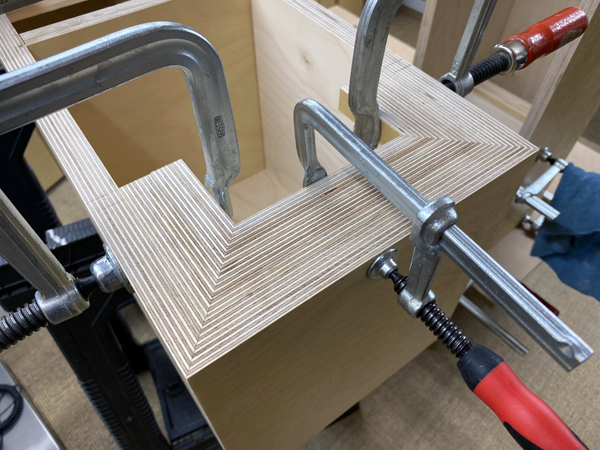
One way of making the tweeter panel. Takes some time, but looks nice - to my eyes.
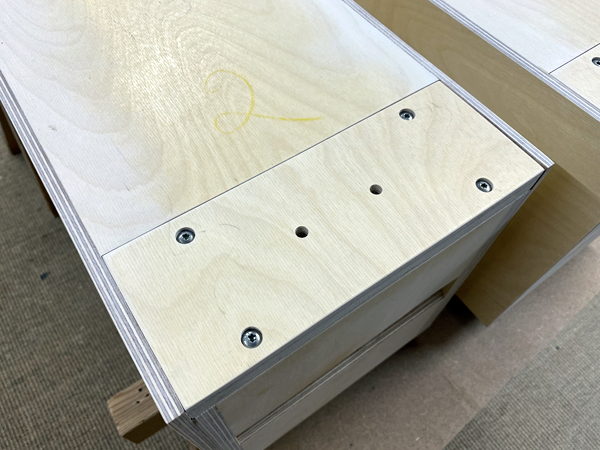
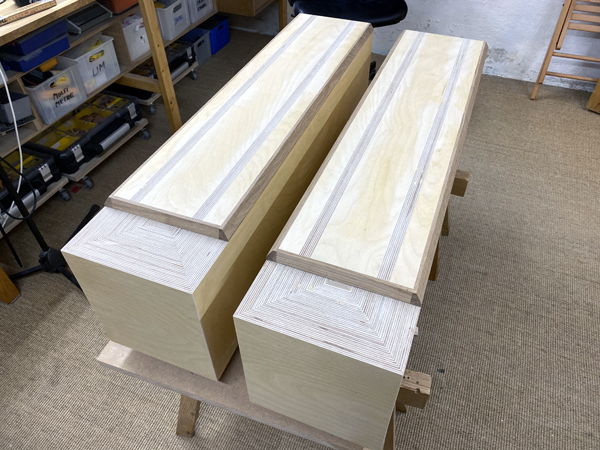
Left: Terminal panel ready. Right: Front panels ready for driver routing.
Chamfering the front panels is optional. Make sure you don't chamfer more than making enough space for the 8" bass driver, 225 mm.
I suggest chamfering to 230 mm effective width.
I used oak fillets for the front panel.
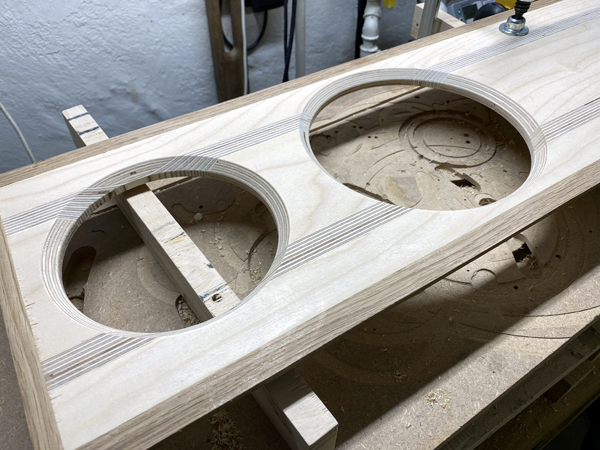
Chamfer driver holes to about half depth.
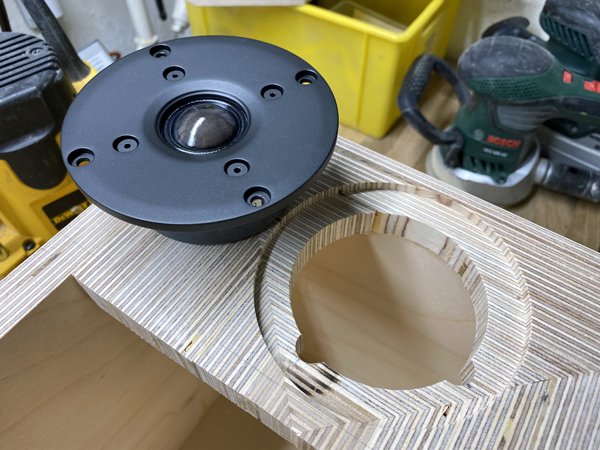
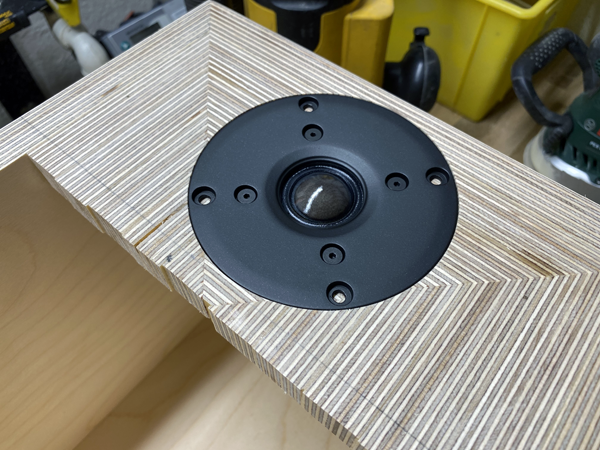
Routing for the tweeter. The 9130 tweeter has this odd non-symmetrical placement of terminals.
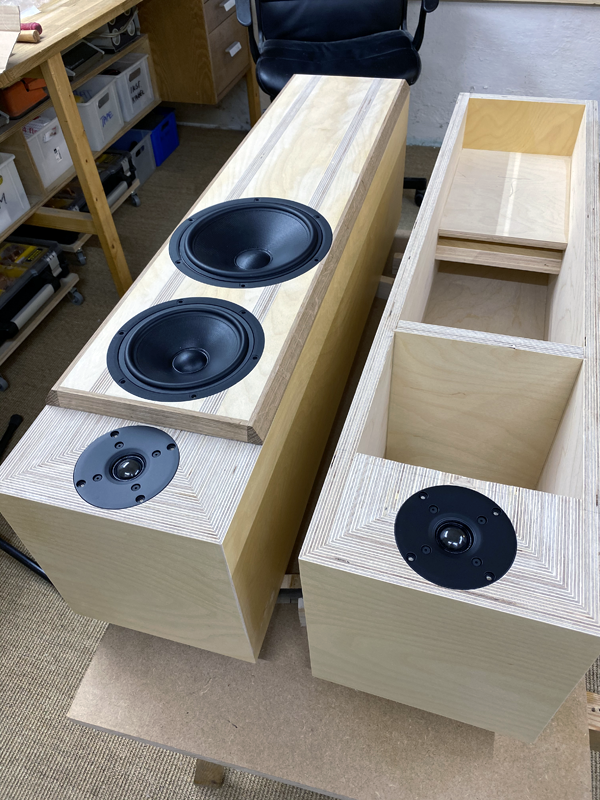
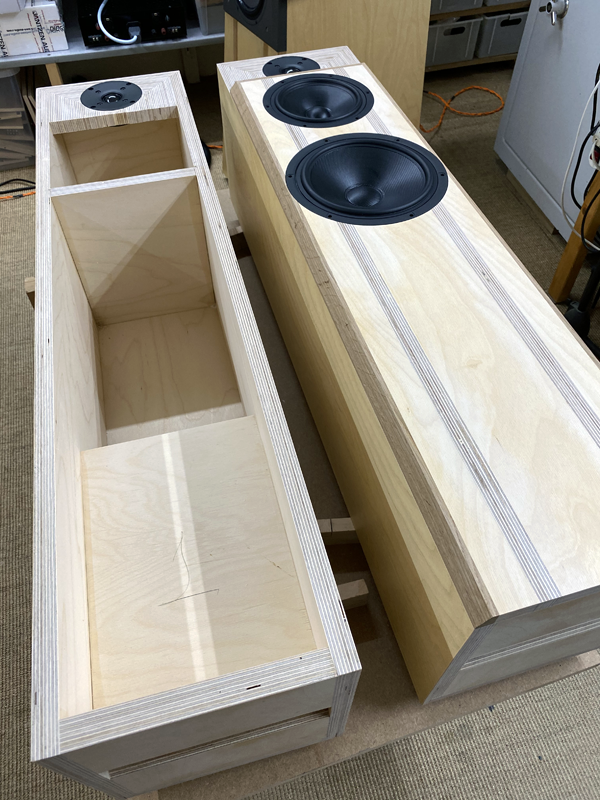
Pretty much ready for damping materials before the fronts are glued on.
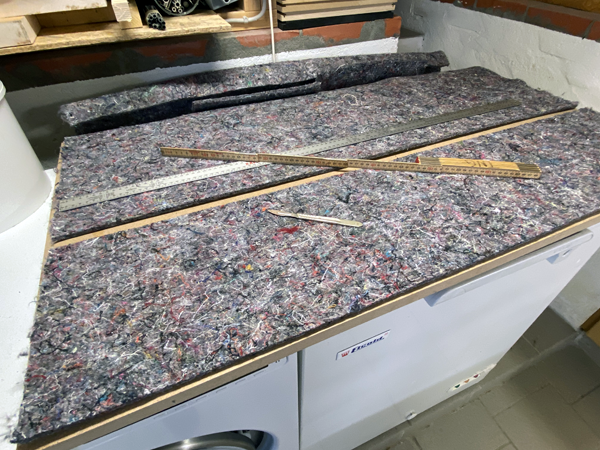
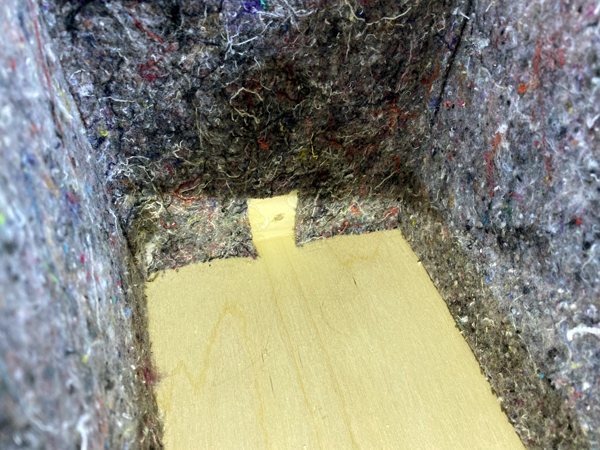
Cutting felt damping sheets. Don't forget to make a hole for the midrange-tweeter wires. Much easier this way than after.
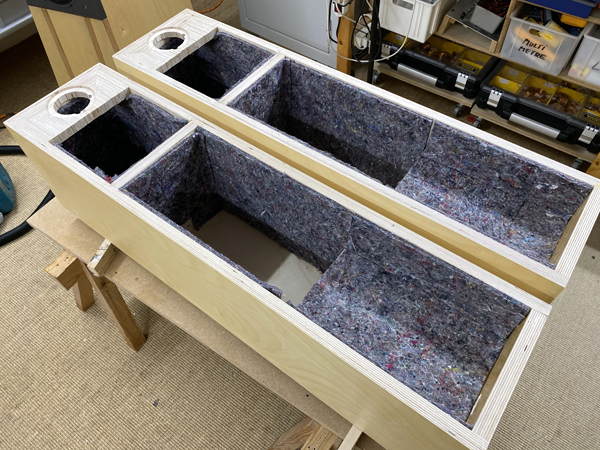
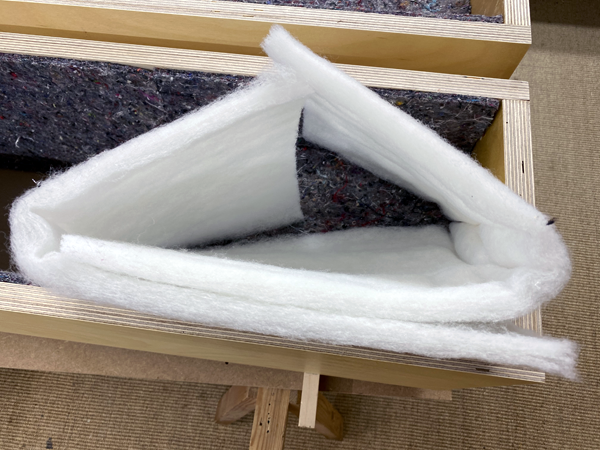
Left: Cabs with all felt in place. Right. Damping of bottom compartments next to the port.
Cut two pieces of 20 x 50 cm acoustilux and fold like seen. This for both sides of the port.
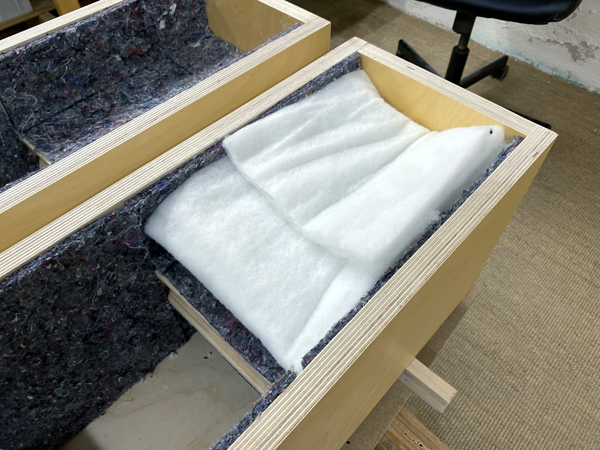
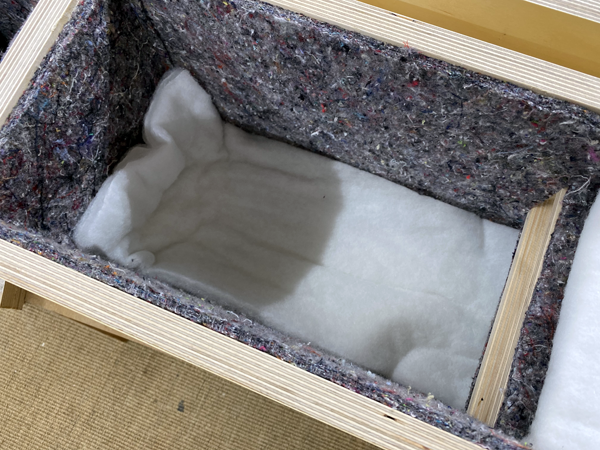
Left: Bottom compartment damped with acoustilux.
Right: Prepare 2 pcs 20 x 50 cm acoustilux to cover the crossover placed on rear panel behind bass driver.
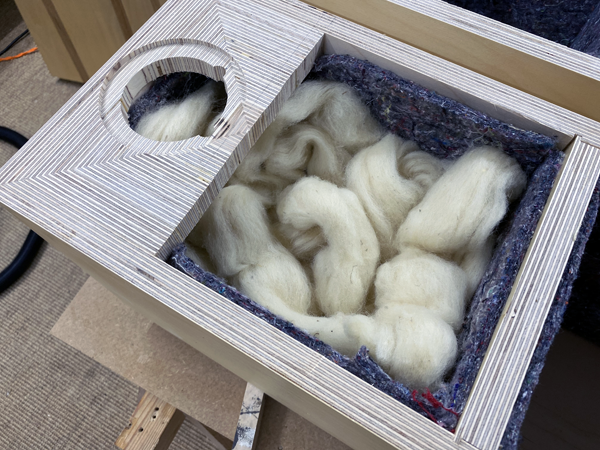
Mid-tweeter compartment filled with 300 grams sheeps wool.
A few comments on
MEASUREMENTS before you start interpreting the readings below.
First of all, if we think measurements will
tell us how a speaker sounds, we're wrong. The perception of sound is
way too subjective to be reflected in any measurements we can perform. A
loudspeaker system is meant to give us a satisfying idea of an acoustic
event and for some people a pair of 5 USD ear-plugs are enough, others
spend 200 kUSD on a truly full-range pair of speakers - and the latter
may not be happier than the former.
Measurements may give us an idea of tonal balance of a system, i.e. too
much or too little energy in certain areas, although dispersion
characteristics play a vital role here. A two-way 7+1 and a three-way
7+4+1 may display similar horizontal dispersion, yet sound very
different. Measurements may tell us about bass extension if far-field
measurements are merged with near-field measurements. In addition to
this, ports may contribute to bass extension. Most of we diy'ers do not
have access to an anechoic room for full-range measurements from
20-20000 Hz.
What cannot be seen is what kind of bass performance we get in a given
room. Bass performance is highly dependent on in-room placement of your
speaker and the same speaker can be boomy in one place and lean in
another. Actual SPL level at 1 meter distance and 2.8V input is useful
for en estimate of system sensitivity and combined with the impedance
profile may give an idea of how powerful an amplifier is needed to drive
the speaker to adequate levels.
What measurements do not tell is the very sound of the speaker unless
displaying serious linear distortion. The level of transparency, the
ability to resolve micro-details, the "speed" of the bass, etc., cannot
be derived from these data. Distortion measurements rarely tell much
unless seriously bad, and most modern drivers display low distortion
within their specified operating range.
Many people put way too much into these graphs and my comments here are
only meant as warning against over-interpretation. There are more to
good sound than what can be extracted from a few graphs. Every graph
needs interpretation in terms of what it means sonically and how it
impacts our choice of mating drivers, cabinet and crossover design.
What measurements certainly do not tell is the sonic signature of the
speaker, because speaker cones made from polypropylene, aluminum,
Kevlar, paper, glass fiber, carbon fiber, magnesium, ceramics or even
diamonds all have their way of adding spices to the stew. Nor do
measurements tell what impact the quality of the crossover components
add to the sound, from state of the art components to the cheapest of
coils and caps, they all measure the same if values are correct, yet
sound very different.
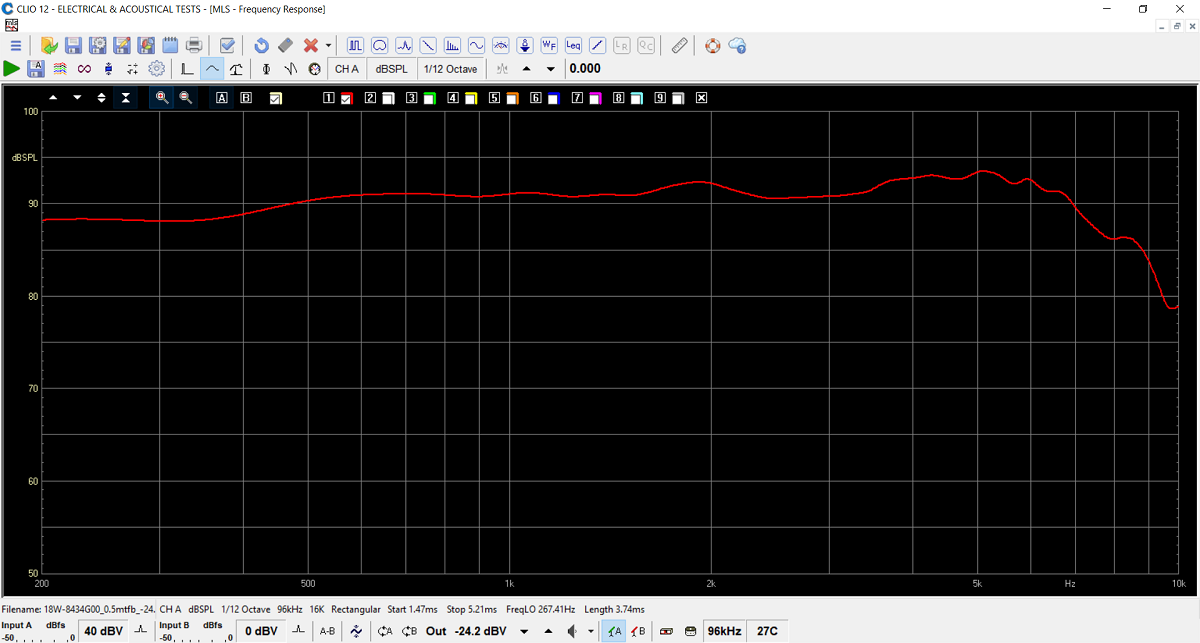
I want to start out with the most important driver here, the
18W/8434G00, on the given baffle.
Now, not since the Ellipticor 18WE have I seen anything like it. Smooth
like a baby's bottom.
Not the slightest hint of any disturbance around 800-1200 Hz, rubber
surround resonances, which is all too common.
Extended range up to 7 kHz! And a smooth roll-off.
You may compared to the Ellipticor here:
http://www.troelsgravesen.dk/Ellipticor-4/18WE-8542-T00_test-cab_vs_4Ohm_B.png
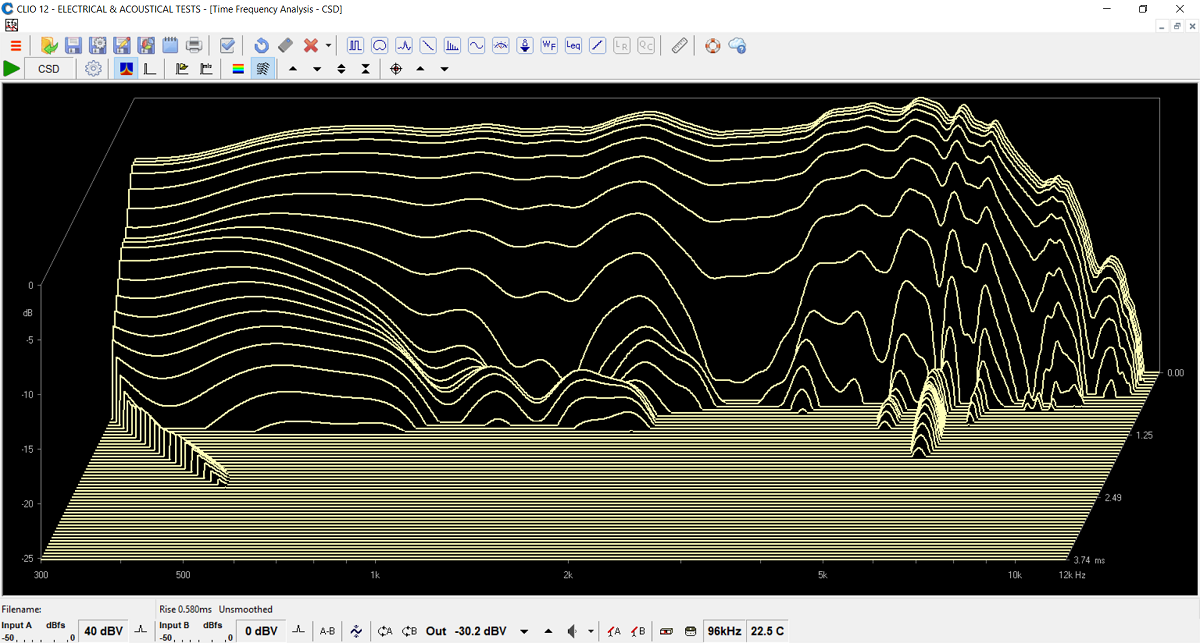
The waterfall plot confirms this excellent performance. Very, very good.
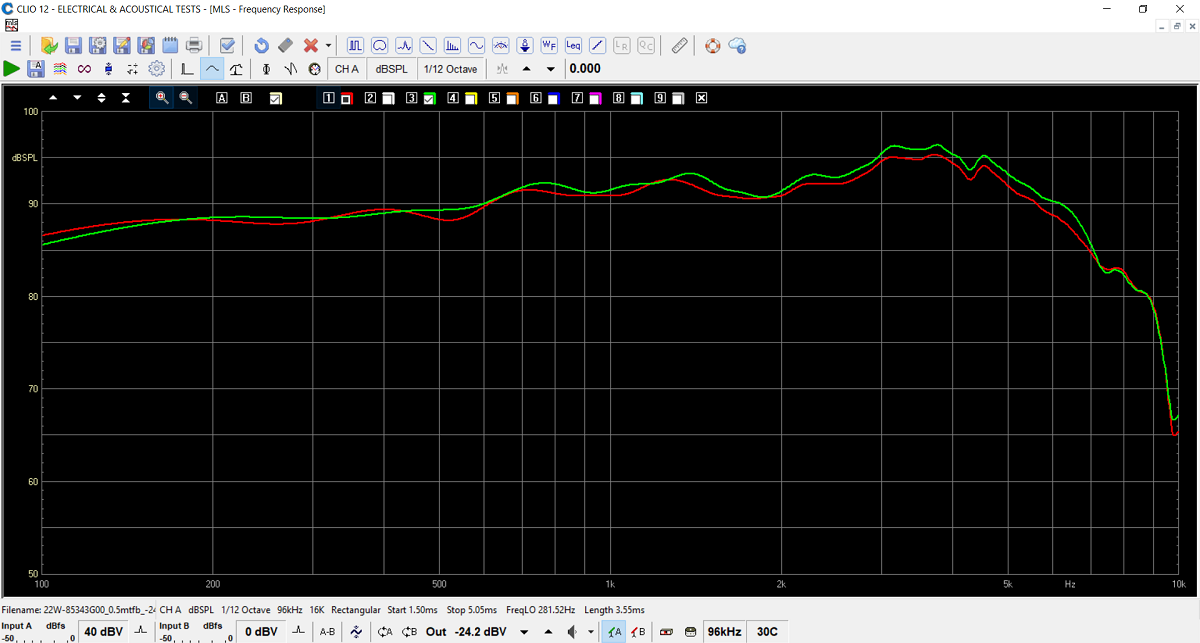
Above the 22W/8534G00 on the actual baffle. Here shown measured at two
different distances. Red = 0.25 meter, green = 0.5 meter.
The 18W and 22W makes life easy as can be seen from crossover.
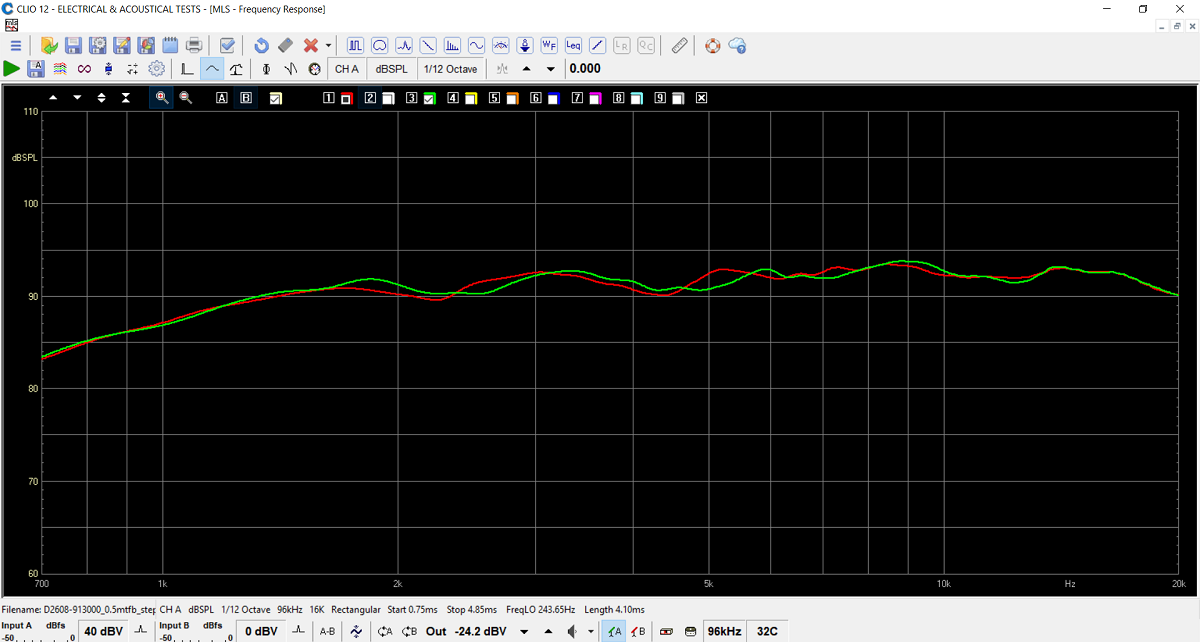
D2608/913000 tweeter on actual baffle measured at 0.25 (red) and 0.5
meter (green) distance.
As easy when it comes to crossover as for the two others.
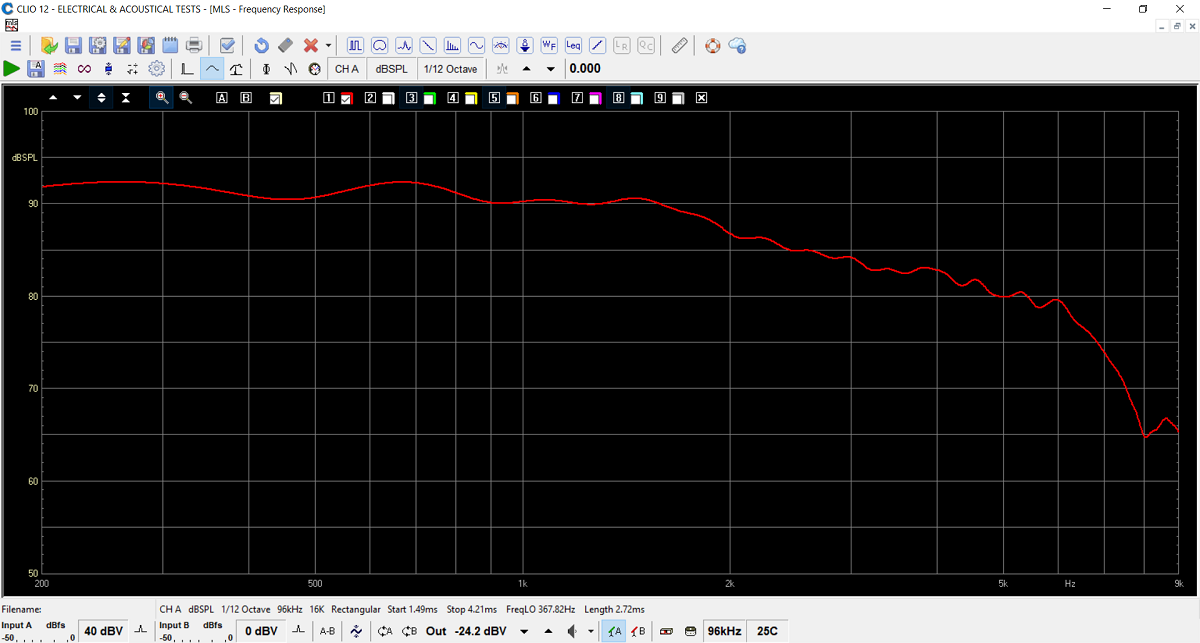
Summed response of 22W and 18W normalised for 1 meter, 2.8 volts. System
sensitivity around 91-92 dB.
Measuring 2½-way systems are notoriously difficult due to the gradual overlap of bass drivers. Thus, I show the combined response of 22W+18W measured at ½ meter distance in the middle between drivers (above) and for 18W and tweeter measured under the same conditions below.
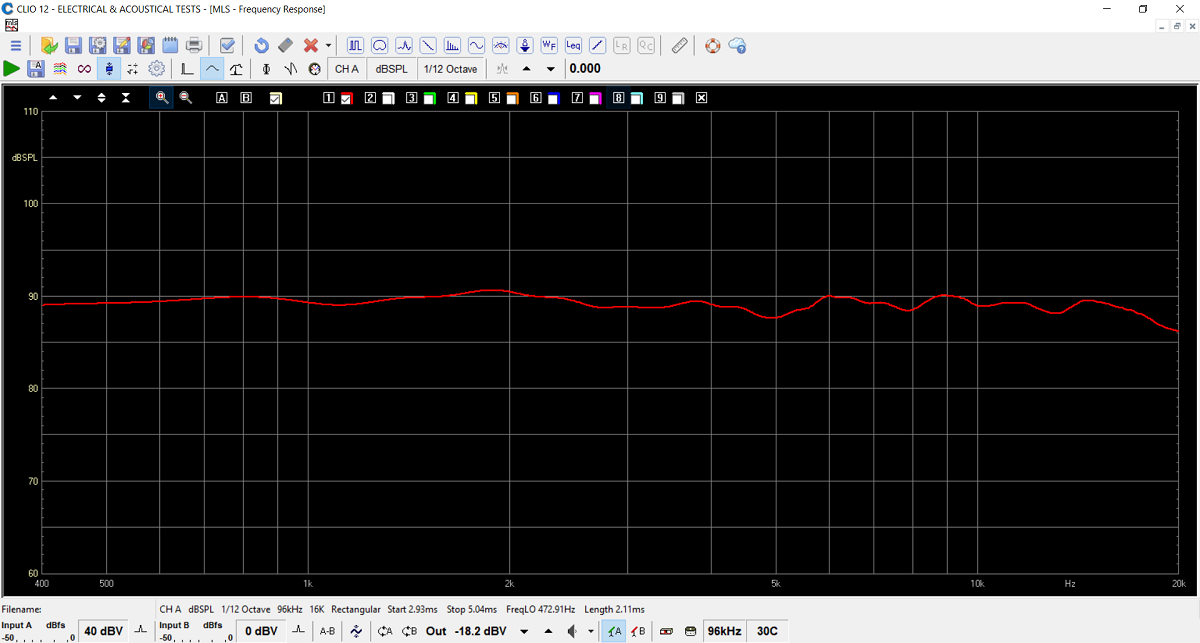
Summed response of 18W and tweeter normalised for 1 meter, 2.8 volts.
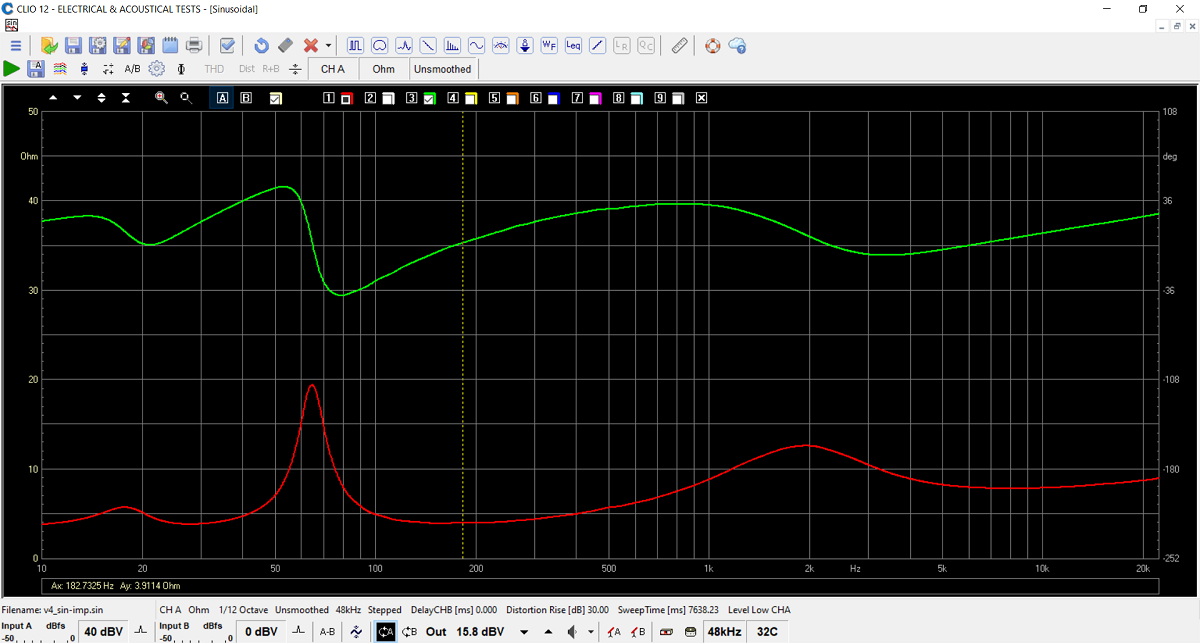
Final system impedance. Minimum 4 Ohms.
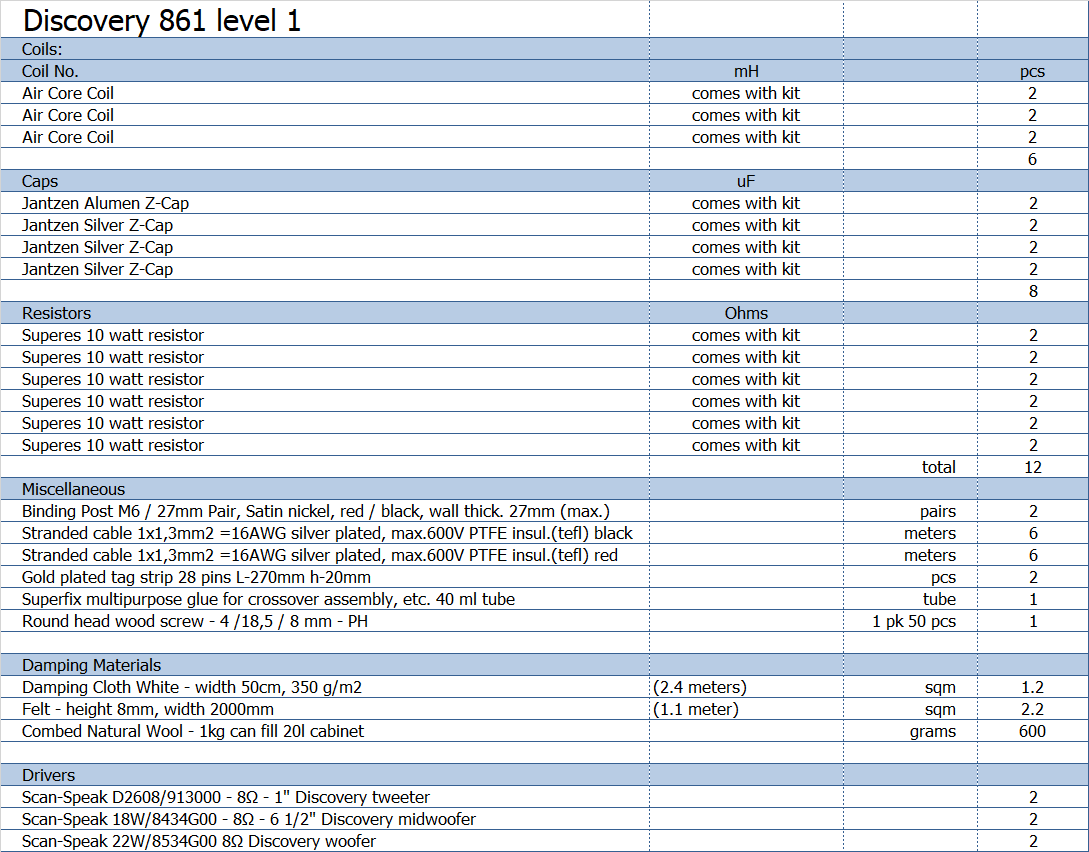
In level 1 we have Alumen-Z for C1 and
Silver-Z for all other caps.
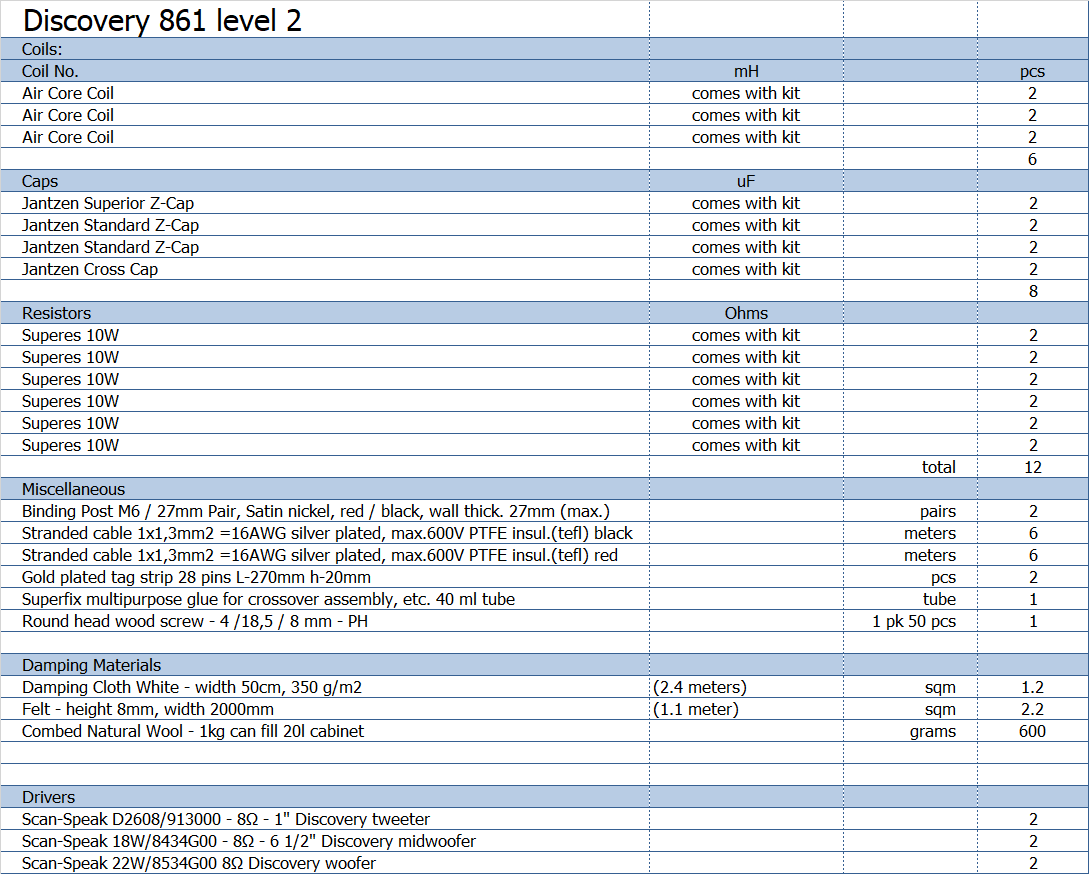
In level 2 we have Superior-Z for C1 and Standard-Z/CrossCap for all
other caps.
All kit and component prices may be subject to change and are always to be confirmed by Jantzen Audio Denmark.
Download Complete Kit Sale Presentations:
All technical questions to troels.gravesen@hotmail.com
All questions regarding purchase of kits, please mail Jantzen Audio at contact@jantzen-audio.com
CROSSOVER-LAYOUT
BACK TO INDEX
Check this out before start making crossovers:
http://www.troelsgravesen.dk/tips.htm#CONSTRUCTION_OF_CROSSOVERS
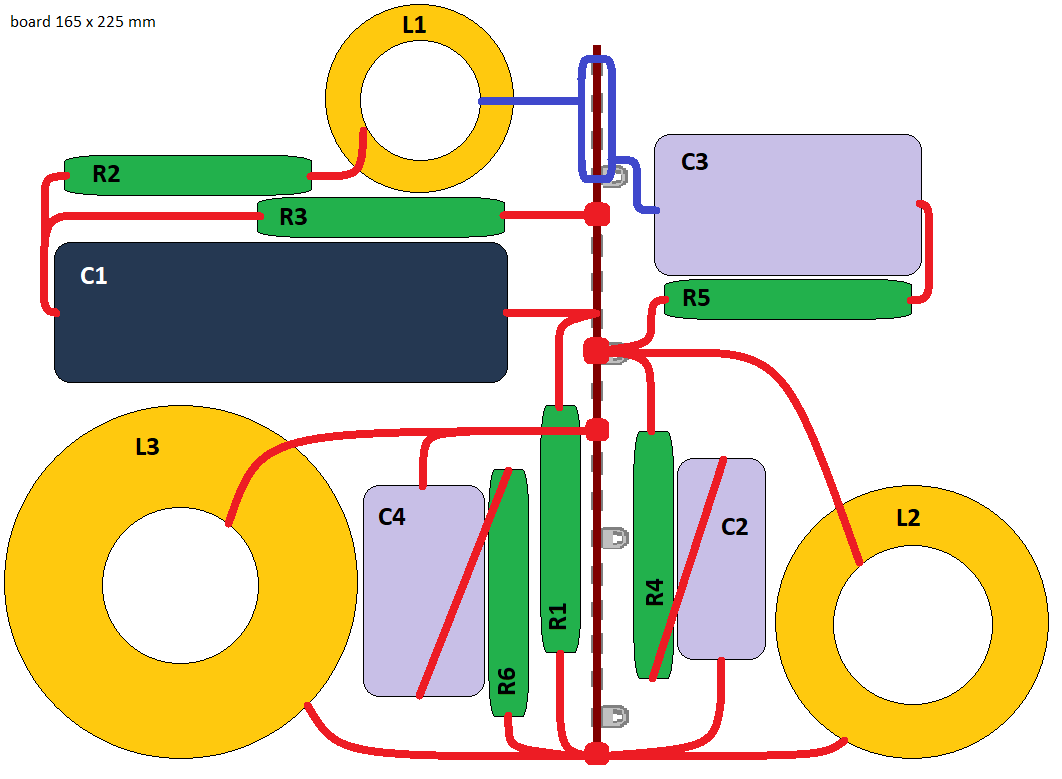
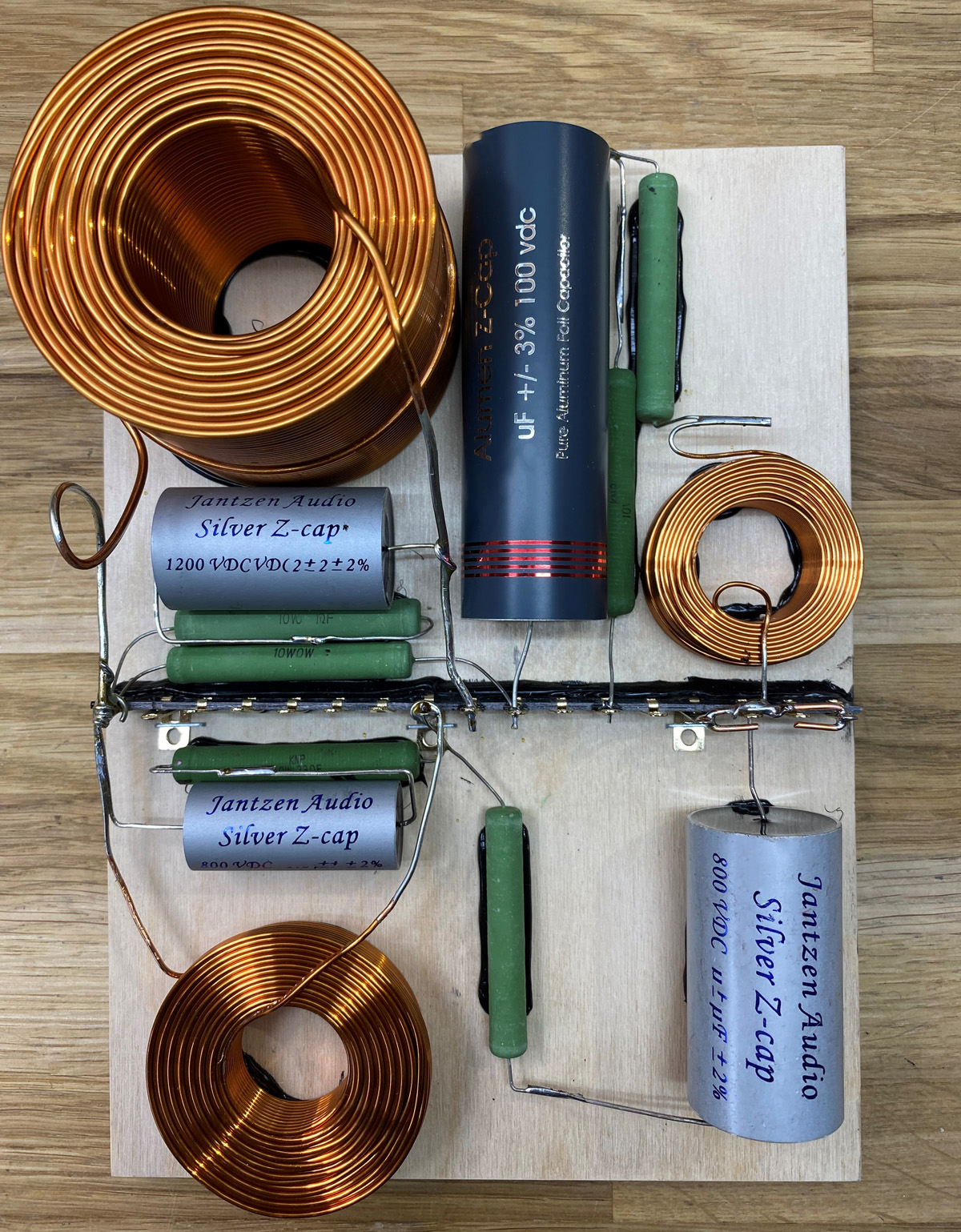
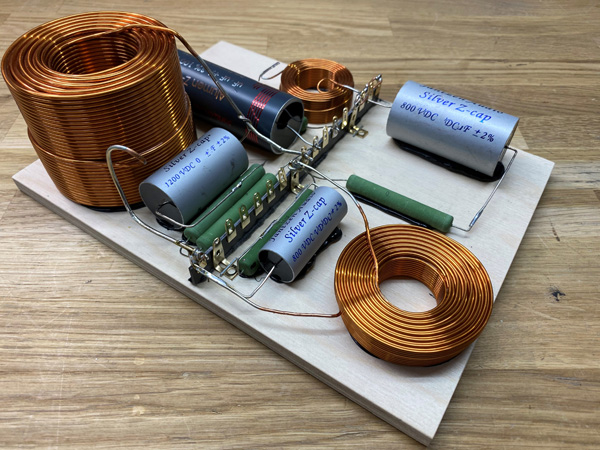
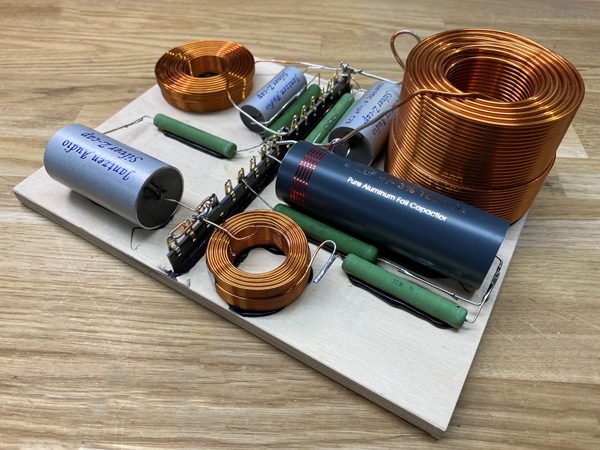
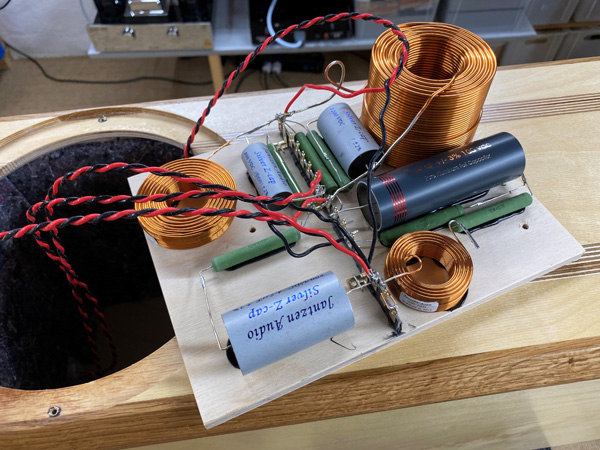
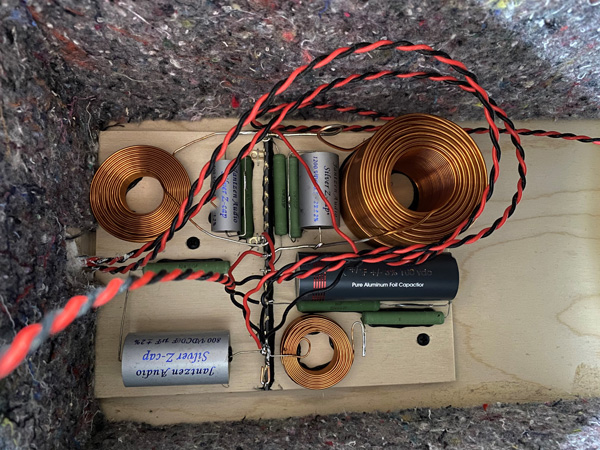
Mounting the speaker wires and board on cabinet rear panel.
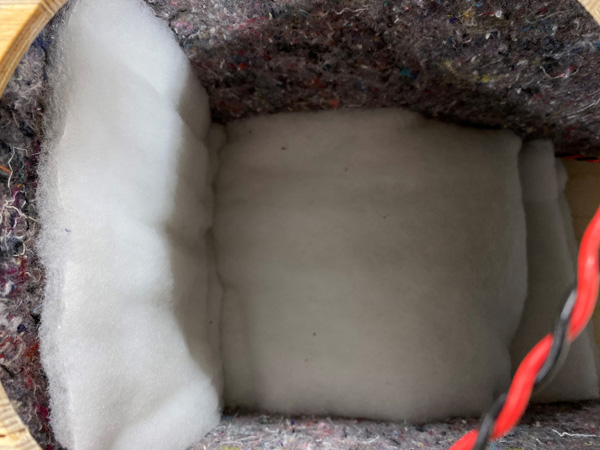
Covering the crossover with two layers of acoustilux.
Speaker wiring
